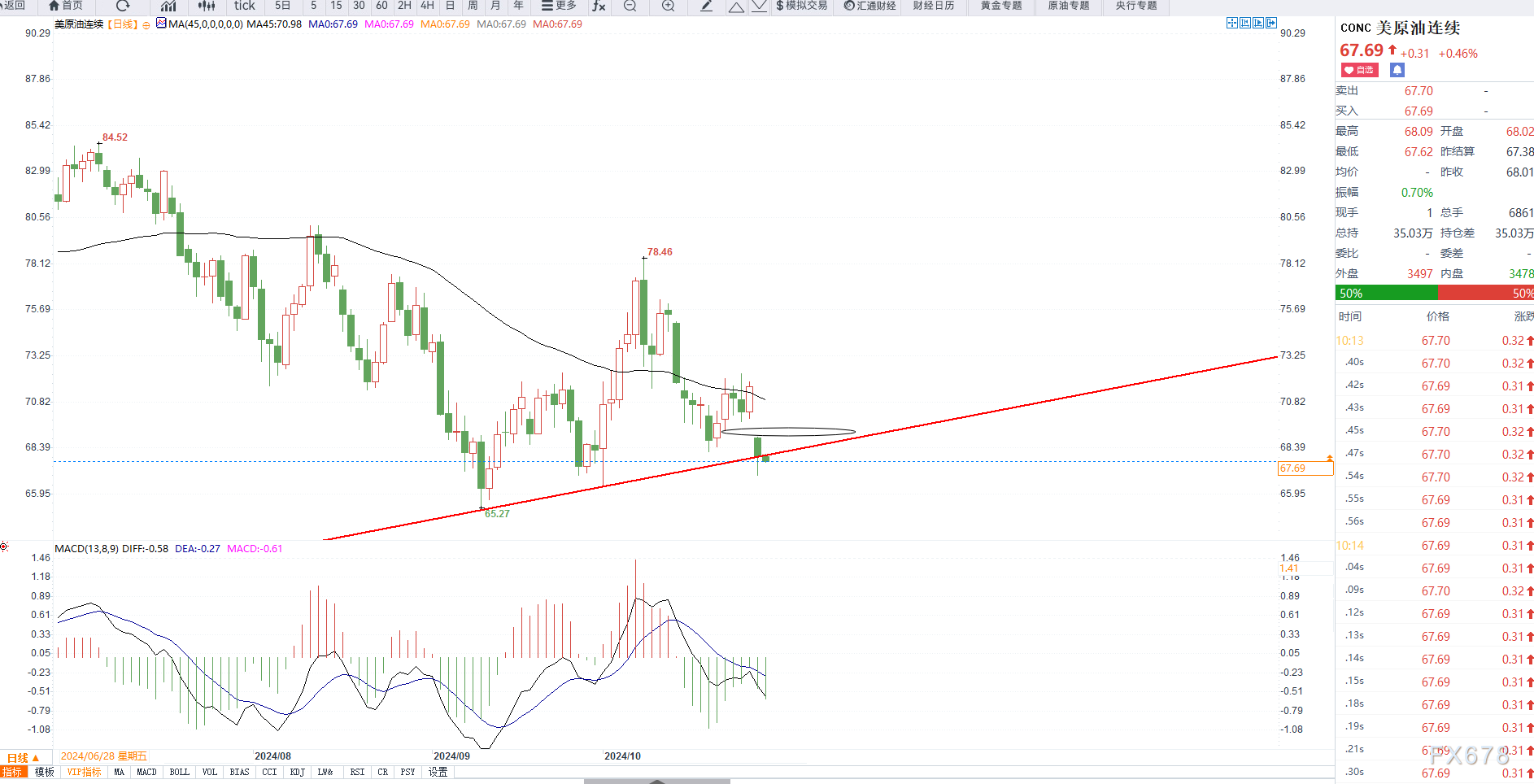The geopolitical situation in the Middle East has eased, further pressure on the supply side has been released, and oil prices continue to fall
On Tuesday (October 29th), US crude oil continued to decline, although it did not fall below Monday's low of $66.92 per barrel, it was close to yesterday's 6% decline. Fundamentally, the geopolitical situation in the Middle East has eased, further releasing pressure on the supply side and putting pressure on oil prices. Although the United States is preparing to seek 3 million barrels of oil reserves, it has not been able to boost oil prices, indicating that the expectation of demand side recovery is relatively weak. Therefore, the short-term fundamentals are bearish, and with the technical level already broken, the possibility of downward acceleration cannot be ruled out.
This trading day, we need to pay attention to the US API crude oil inventory data to see if it continues to rise, thereby putting pressure on oil prices to further decline.
The United States announced on Monday that it is seeking to purchase up to 3 million barrels of oil to replenish its Strategic Petroleum Reserve (SPR), which will be delivered before May next year. Before lawmakers approve more funds, the government's oil purchase funds will be running low after this purchase.
These oil will be transported to the SPR base in Bryan Mound, Texas between April and May 2025, the latest measure taken to supplement SPR following the record breaking sale of 180 million barrels of oil in the United States in 2022.
After Russia's full-scale invasion of Ukraine, gasoline prices soared and US President Biden ordered the sale of oil. At present, the US Department of Energy has repurchased over 55 million barrels of oil at an average price of about $76 per barrel, nearly $20 lower than the selling price of $95 per barrel in 2022.
As part of the effort to supplement SPR, the Department of Energy also worked with lawmakers at the end of 2022 to cancel the congressional plan to sell 140 million barrels of oil by 2027. Democratic and Republican lawmakers have voted in favor of selling the plan to pay for government projects.
It is currently unclear how much funds the Ministry of Energy has left to purchase more oil. Earlier this month, a source from the Department of Energy stated that there is still approximately $150 million left, enough to buy about 2 million barrels of oil.
But obviously there will be more. A spokesperson for the Department of Energy stated on Monday, "The Department of Energy will continue to use available emergency revenue to purchase crude oil for taxpayers at good prices." The Biden administration or the next administration will need to work with Congress to supplement the Department of Energy's SPR purchase fund.
The SPR oil account funds are about to run out, and Congress has a responsibility to further replenish them, but the politicization of SPR may make it difficult for lawmakers to reach a consensus, "said Kevin Book, a policy analyst at the non partisan research firm ClearView Energy Partners. Book estimates that 'theoretically' there will still be some remaining funds after the most recent transaction is completed, but not a lot.
Collaborating with lawmakers to resolve SPR issues may also involve canceling the plan set by Congress years ago to sell approximately 100 million barrels of oil from 2026 to 2031
The Citibank analyst team led by Max Layton stated in a report that, considering the recent low risk premium, Citibank has lowered its Brent oil price target for the next three months from $74 per barrel to $70 per barrel.
In October, OPEC+, consisting of the Organization of the Petroleum Exporting Countries (OPEC) and oil producing allies, maintained its oil production policy unchanged, including plans to increase production from December onwards. OPEC will hold a meeting before the OPEC+plenary session on December 1st.
Tudor Pickering Holt analyst Matt Portillo said that the trading price of US crude oil futures in the next year may be much lower than it is now.
Portillo said, "If there is no conflict in the Middle East, our baseline forecast for US crude oil in 2025 will still be $65 per barrel. If OPEC+does not show significant restrictions on increasing production, then the price of US crude oil will tend to be lower
From a technical perspective, the daily level has fallen below the convergence zone support, but has not yet accelerated. If the EIA inventory data continues to increase this week, it will create a supply-demand double kill for oil prices. If the intraday level breaks below $66.8, the bearish trend will accelerate and short-term pullback pressure will be around $69

Daily chart of US crude oil
Tips:This page came from Internet, which is not standing for FXCUE opinions of this website.
Statement:Contact us if the content violates the law or your rights
